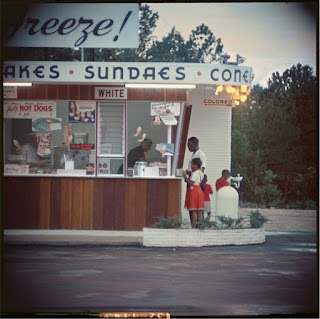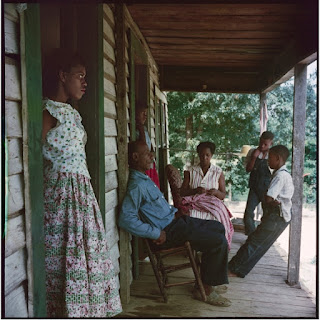by Nomad
 In honor of the tenth anniversary of the death of photographer, film director, musician, and writer Gordon Parks, we look at the man's life and work. His images serve to remind us that when people talk about taking America back to a better time, we need to pay close attention what they mean to every American.
In honor of the tenth anniversary of the death of photographer, film director, musician, and writer Gordon Parks, we look at the man's life and work. His images serve to remind us that when people talk about taking America back to a better time, we need to pay close attention what they mean to every American.
To appreciate the photography of Gordon Parks- or any artist- we need to understand his origins and his early experiences.
Hard Times in the Heartland
Parks was born on November 30, 1912, in Fort Scott, Kansas, the youngest of fifteen children. According to his biography, his family was dirt-poor in a town of considerable racial tension.
When Gordon was 15, his mother died and he was sent to live with a sister and her husband in St. Paul, Minnesota. After an argument with his hosts, Parks ended up a homeless high school dropout.
Fortunately for him, he had a natural talent for the piano and, after a series of jobs, he joined a touring band. That gig took him to New York.
After the band broke up, Parks again faced hard times, this time in Harlem. During the Great Depression, he was living in a rat-infested tenement and unable to find work.
In 1933, he joined the Civilian Conservation Corps (CCC). part of FDR's recovery program after the Great Depression.
Around this time, he married Sally Alvis in 1933 and returned to St. Paul a year later. He found work as a dining-car waiter and porter on the North Coast Limited. The couple had three children, Gordon, Jr., Toni, and David.
The Vision of an Invisible Man
One could say that at this point, Gordon's story was not a particularly distinctive life. He gave no outward sign that he would go on to do great things or even that he had impressive talents, outside of his musical ability. Had you been around at that time, it might have been easy to overlook this practically invisible man.
Looking back at those hard times, Parks wrote:
I suffered evils, but without allowing them to rob me of the freedom to expand.What changed his life was the purchase of a pawned camera. He once recalled:
"I bought my first camera in a pawn shop there. It was a Voigtlander Brilliant and cost $12.50. With such a brand name, I could not resist."
He became interested in the low-income black neighborhoods of Chicago's South Side. In 1941, Parks won a photography fellowship with the Farm Security Administration for his images of the inner city.
From that work came one of Parks iconic photos of a cleaning woman standing before an American flag. It is a powerful but subtle image which- like all great photography- says so much but so gently. It seems to say that America, with all of its symbols of glory, looks very different from the eyes of anybody whose freedoms are conditional to the majority.
Later, Parks would also become a writer, and turn to filmmaking. He wrote the screenplay for the 1969 film adaptation of his own' novel, The Learning Tree. With this project, he became the first African-American to direct a major Hollywood movie. He also composed the score for the film.
This semi-autobiographical film is a story about a young African American man who grows up in rural Kansas during the late 1920s and early 1930s. At that time, racial discrimination was not only legally sanctioned in parts of the United States but socially accepted part of American culture.
This semi-autobiographical film is a story about a young African American man who grows up in rural Kansas during the late 1920s and early 1930s. At that time, racial discrimination was not only legally sanctioned in parts of the United States but socially accepted part of American culture.
This is by no means a proper summary of his long and creative career. For a complete biography, click here.
On 7 March 2006, Parks died of cancer at the age of 93 in New York City and is buried in his hometown of Fort Scott, Kansas, where he started his journey.
* * *
In memory of Gordon Parks, I offer you this series of images from Alabama in 1950s, entitled Segregation Story, 1956 a Life magazine assignment to document an extended African American family living in Jim Crow segregation in the pre-Civil rights era.









